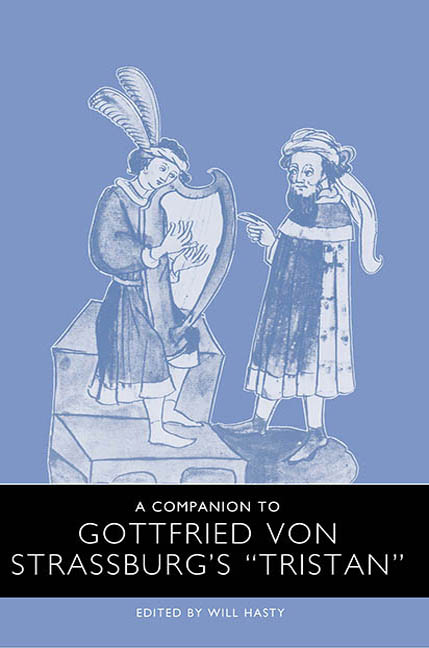Book contents
- Frontmatter
- Contents
- Acknowledgments
- Introduction: The Challenge of Gottfried's Tristan
- I Cultural and Social Contexts
- II Figures, Themes, Episodes
- Gottfried's Adaptation of the Story of Riwalin and Blanscheflur
- This Drink Will Be the Death of You: Interpreting the Love Potion in Gottfried's Tristan
- God, Religion, and Ambiguity in Tristan
- The Female Figures in Gottfried's Tristan and Isolde
- Performances of Love: Tristan and Isolde at Court
- Duplicity and Duplexity: The Isolde of the White Hands Sequence
- III Gottfried's Narrative Art
- IV The Medieval and Modern Reception of Gottfried's Tristan
- Notes on the Contributors
- Index
Performances of Love: Tristan and Isolde at Court
from II - Figures, Themes, Episodes
Published online by Cambridge University Press: 28 April 2017
- Frontmatter
- Contents
- Acknowledgments
- Introduction: The Challenge of Gottfried's Tristan
- I Cultural and Social Contexts
- II Figures, Themes, Episodes
- Gottfried's Adaptation of the Story of Riwalin and Blanscheflur
- This Drink Will Be the Death of You: Interpreting the Love Potion in Gottfried's Tristan
- God, Religion, and Ambiguity in Tristan
- The Female Figures in Gottfried's Tristan and Isolde
- Performances of Love: Tristan and Isolde at Court
- Duplicity and Duplexity: The Isolde of the White Hands Sequence
- III Gottfried's Narrative Art
- IV The Medieval and Modern Reception of Gottfried's Tristan
- Notes on the Contributors
- Index
Summary
The ability to craft and appreciate art has been recognized as a necessary prerequisite for the articulation and comprehension of Gottfried's literary conception (among the many studies focusing on artistry in Gottfried's romance are those of Mohr, Jackson, and Kästner). This becomes clear already in the prologue, where Gottfried directs his tale to his audience, the elite group of “noble hearts,” or edele herzen.The implicit references that Gottfried makes here to the literature of antiquity, particularly when he disagrees with Ovid by recommending stories of love to people who are unhappily in love (see Ovid verses 757– 66 and Gottfried's Tristan 101–10), suggest that the self-understanding of Gottfried's audience must have been grounded at least in part in a knowledge and appreciation of the literary culture of antiquity — even if Gottfried frequently parts ways with this culture (see Wolf's chapter in this volume). Gottfried's close familiarity with antique literature and the liberal arts has long been stressed in the critical literature on Tristan. As Walter Haug points out (207–8), art is inextricably bound in Gottfried's literary conception to a moral betterment that is achieved by remembering, appreciating, and vicariously experiencing the joys and pains of the lovers Tristan and Isolde (in a manner that is analogous to the way Christians remembered Christ's suffering by means of the Eucharist; see 33–44). Already in the fourth quatrain of the strophic prologue, art is being closely linked to honor and praise — of which Tristan and Isolde, as the embodiments of an ideal love, and the audience of edele herzen, by virtue of their devoted remembrance of these exemplary lovers, are implicitly deserving:
Êre unde lop diu schepfent list,
dâ list ze lobe geschaffen ist:
swâ er mit lobe geblüemet ist,
dâ blüejet aller slahte list. (21–24)
(Praise and esteem bring art on where art deserves commendation. When art is adorned with praise it blossoms in profusion. [Translations are from Hatto])
The list mentioned here is frequently and justifiably understood as art (and translated as such, for example by Hatto here), though it might also be seen as referring more generally to any technique or stratagem whereby a pleasing and beneficial effect is achieved by means of the resourceful application of acquired knowledge (for studies of list in Gottfried's text, see Jacobson and Jupé).
- Type
- Chapter
- Information
- A Companion to Gottfried von Strassburg's Tristan , pp. 159 - 182Publisher: Boydell & BrewerPrint publication year: 2003



